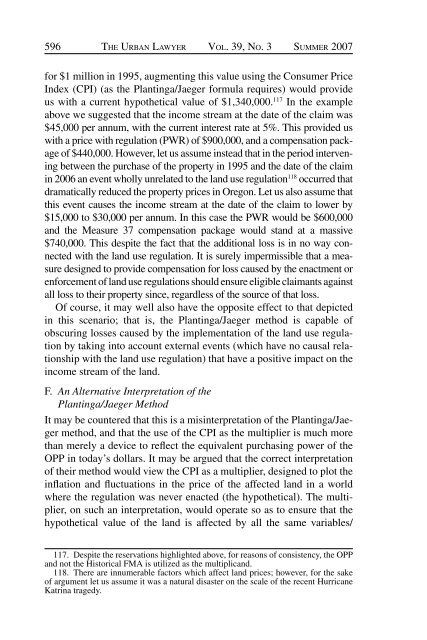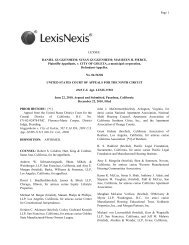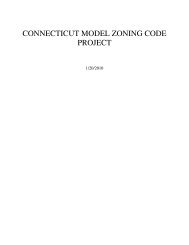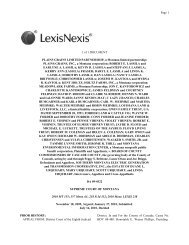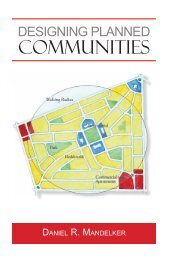Through a Glass Darkly: Measuring Loss Under ... - Land Use Law
Through a Glass Darkly: Measuring Loss Under ... - Land Use Law
Through a Glass Darkly: Measuring Loss Under ... - Land Use Law
You also want an ePaper? Increase the reach of your titles
YUMPU automatically turns print PDFs into web optimized ePapers that Google loves.
596 THE URBAN LAWYER VOL. 39, NO. 3 SUMMER 2007<br />
for $1 million in 1995, augmenting this value using the Consumer Price<br />
Index (CPI) (as the Plantinga/Jaeger formula requires) would provide<br />
us with a current hypothetical value of $1,340,000. 117 In the example<br />
above we suggested that the income stream at the date of the claim was<br />
$45,000 per annum, with the current interest rate at 5%. This provided us<br />
with a price with regulation (PWR) of $900,000, and a compensation package<br />
of $440,000. However, let us assume instead that in the period intervening<br />
between the purchase of the property in 1995 and the date of the claim<br />
in 2006 an event wholly unrelated to the land use regulation 118 occurred that<br />
dramatically reduced the property prices in Oregon. Let us also assume that<br />
this event causes the income stream at the date of the claim to lower by<br />
$15,000 to $30,000 per annum. In this case the PWR would be $600,000<br />
and the Measure 37 compensation package would stand at a massive<br />
$740,000. This despite the fact that the additional loss is in no way connected<br />
with the land use regulation. It is surely impermissible that a measure<br />
designed to provide compensation for loss caused by the enactment or<br />
enforcement of land use regulations should ensure eligible claimants against<br />
all loss to their property since, regardless of the source of that loss.<br />
Of course, it may well also have the opposite effect to that depicted<br />
in this scenario; that is, the Plantinga/Jaeger method is capable of<br />
obscuring losses caused by the implementation of the land use regulation<br />
by taking into account external events (which have no causal relationship<br />
with the land use regulation) that have a positive impact on the<br />
income stream of the land.<br />
F. An Alternative Interpretation of the<br />
Plantinga/Jaeger Method<br />
It may be countered that this is a misinterpretation of the Plantinga/Jaeger<br />
method, and that the use of the CPI as the multiplier is much more<br />
than merely a device to reflect the equivalent purchasing power of the<br />
OPP in today’s dollars. It may be argued that the correct interpretation<br />
of their method would view the CPI as a multiplier, designed to plot the<br />
inflation and fluctuations in the price of the affected land in a world<br />
where the regulation was never enacted (the hypothetical). The multiplier,<br />
on such an interpretation, would operate so as to ensure that the<br />
hypothetical value of the land is affected by all the same variables/<br />
117. Despite the reservations highlighted above, for reasons of consistency, the OPP<br />
and not the Historical FMA is utilized as the multiplicand.<br />
118. There are innumerable factors which affect land prices; however, for the sake<br />
of argument let us assume it was a natural disaster on the scale of the recent Hurricane<br />
Katrina tragedy.<br />
ABA-TUL-07-0701-Sullivan.indd 596<br />
9/18/07 10:43:43 AM


